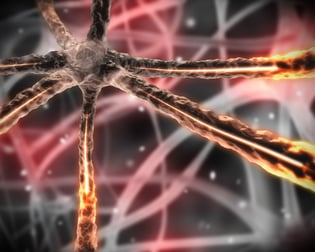Peripheral neuropathy is a serious condition resulting from damage to your peripheral nerves – those outside your brain and spinal cord. The causes of peripheral neuropathy vary, but the condition is typically marked by painful tingling in the hands and feet called paresthesia.
The symptoms of peripheral neuropathy (paresthesia, muscle weakness, and more) can be serious enough to preclude you from work. If you’re in this position, you may have questions on how best to present your peripheral neuropathy to your insurance company for benefit approval.
Here are several things you need to know before filing your long term disability claim for peripheral neuropathy.
Understanding Peripheral Neuropathy
You may be familiar with the central nervous system, which consists of your brain and spinal cord.
 The peripheral nervous system is made up of all the nerves outside of the brain and spinal cord, including the nerves that connect your spinal cord to the rest of your spine. Both nervous systems are vital to your body’s functionality, such as controlling motor movement and transferring sensory information (for example, heat and cold on your skin).
The peripheral nervous system is made up of all the nerves outside of the brain and spinal cord, including the nerves that connect your spinal cord to the rest of your spine. Both nervous systems are vital to your body’s functionality, such as controlling motor movement and transferring sensory information (for example, heat and cold on your skin).When these peripheral nerves are damaged, it can cause neuropathy. Neuropathy manifests in muscle weakness and pain, usually a painful tingling in the hands and feet. There are generally two types of neuropathies: mononeuropathy (involving damage to only one nerve) and polyneuropathy (involving multiple nerves).
Of the two, polyneuropathy is more prevalent. Both types can cause severe and disabling symptoms.
Is Peripheral Neuropathy A Disability?
Symptoms of peripheral neuropathy vary in frequency, severity, and duration. When severe enough, peripheral neuropathy can result in disability. The type of symptoms and level of disability an individual experiences depends heavily on the type of nerve that is damaged.
The three main types of nerves that can be damaged include:
-
-
- Sensory nerves;
- Motor nerves; and
- Autonomic nerves.
-
Sensory Nerve Damage
Sensory nerve damage affects your ability to feel things to the touch, such as temperature or pain. For example, you may not notice that a hot stove has burned your hand. You may also experience heightened sensations and/or abnormal pain.
Sensory nerve damage most commonly affects the extremities, particularly the hands and feet.
Motor Nerve Damage
Motor nerve damage can result in many serious symptoms, such as:
-
-
- Problems controlling muscle movements used for walking, talking, or grasping;
- Muscle twitching;
- Muscle atrophy;
- Poor reflexes.
-
If you experience difficulty controlling motor movements, such as turning your foot or clutching an object, you may have suffered nerve damage.
Autonomic Nerve Damage
Autonomic nerves are the nerves controlling your internal organ functions. When autonomic nerve damage occurs, symptoms can include:
-
-
- Loss of bladder control
- Unusually high or low blood pressure
- Difficulty breathing or swallowing
- Gastrointestinal function problems.
-
This is the most serious of the three types of nerve damage. Loss of autonomic functioning may require very intensive care.
Causes of Peripheral Neuropathy
There are many causes of peripheral neuropathy. These causes may include:
-
-
- Traumatic injury (e.g., a fall or car accident);
- Repetitive stress injury (e.g., typing and computer usage);
- Autoimmune diseases (e.g., rheumatoid arthritis)
- Small vessel disease (e.g., vasculitis)
- Metabolic and endocrine disorders (e.g., diabetes);
- Kidney disorders (e.g., kidney failure);
- Neuromas (causing benign tumors on the nerve tissue);
- Infections (e.g., Lyme disease);
- Exposure to toxic substances (e.g., alcohol abuse)
-
Proving Peripheral Neuropathy For Long Term Disability
When you file your long term disability claim for peripheral neuropathy, the insurance company will want to see clinical signs and symptoms clearly documented in your medical records. But, the insurance company will be even more concerned with your diagnostic testing results and that you are seeking appropriate treatment.
Clinical Testing for Peripheral Neuropathy
There are numerous tests that can objectively demonstrate the presence of peripheral neuropathy. These tests include:
-
-
- Electromyography (“EMG”);
- Nerve conduction study (“NCV”);
- Magnetic resonance imaging (“MRI”);
- Nerve biopsy; and
- Skin biopsy.
-
Consider getting these tests before filing your long term disability claim.
Appropriate Treatment for Peripheral Neuropathy
Depending on the terms of your long term disability policy, the insurance company may require that you are receiving “appropriate” treatment. The insurance company may also require that you are compliant with such treatment and making every effort to recover. For treatment to be appropriate, the insurance company will want to see that you are under the care of a qualified specialist such as a neurologist.
The insurance company may also want to see that you are receiving appropriate treatment for the underlying cause of your peripheral neuropathy. For example, if your doctors believe that your peripheral neuropathy is caused by diabetes, you should follow up with your internist and/or endocrinologist to address the underlying diabetes. 
The insurance company will also want to see that you are compliant with the treatment plan, which could include medications, lifestyle changes, etc.
If your peripheral neuropathy is causing significant pain, the insurance company may want to see that you are receiving appropriate care to address the pain. Appropriate care to address the pain may include a transcutaneous electrical nerve stimulation (“TENS”) device or medications.
The insurance company may also want to see that you have considered surgical options. For example, carpal tunnel syndrome (a mononeuropathy) may improve with surgical decompression at the wrist.
Explain How Your Peripheral Neuropathy Prevents You From Working
To qualify for long term disability benefits due to peripheral neuropathy, your condition must be severe enough to significantly diminish your ability to perform your work.
If your work is physical or requires you to be on your feet, your peripheral neuropathy may make it very difficult for you to work. You may be unable to tolerate the prolonged standing/walking or use the tools required to perform your job. It may also become difficult or dangerous for you to navigate your work environment. In some cases, you may even pose a physical danger to others (e.g., a surgeon with decreased sensation and weakness in the hands).
Even if your work is sedentary (e.g., a desk job), your peripheral neuropathy may be disabling. Your condition may be disabling if your symptoms worsen with prolonged sitting, you have difficulty getting up from the seated position, or you lack the fine motor skills necessary to use a computer on a sustained basis.
Make sure to document the specific ways your neuropathy interferes with your job duties.
Conclusion
Getting a long term disability insurance claim approved for peripheral neuropathy can be a difficult process. The insurance company will demand objective evidence of your diagnosis, symptoms, and the specific way your condition hinders your ability to continue working. An experienced long term disability attorney can help you prepare the strongest, most substantial claim for your best chance at approval for benefits.




 212-297-0700
212-297-0700










